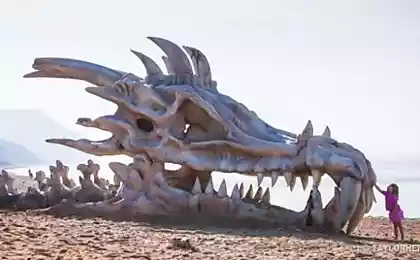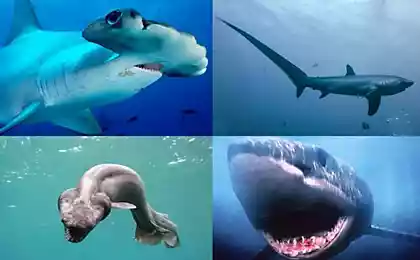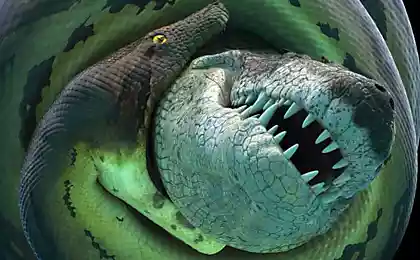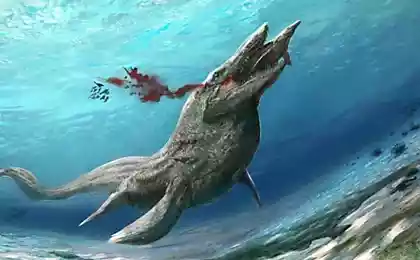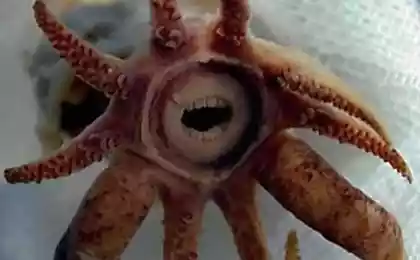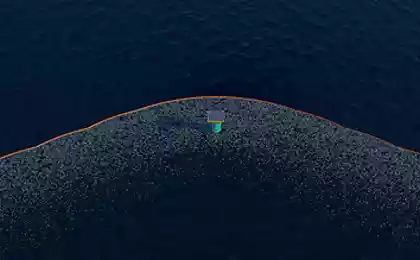1831
Megalodon - the master of ancient oceans (18 photos)
Megalodon was one of the greatest predators that ever existed in the ocean. More than 14 million years he reigned supreme in the coastal seas of our planet. But draw power does not last forever. About 1, 6 million years ago Megalodon suddenly and mysteriously disappeared. With us remained his younger cousin - white shark continues to cause fear, admiration and curiosity. Riddle Megalodon extinction and survival of a large white - one of the greatest mysteries of paleontology. Is it possible to get closer to unraveling it?
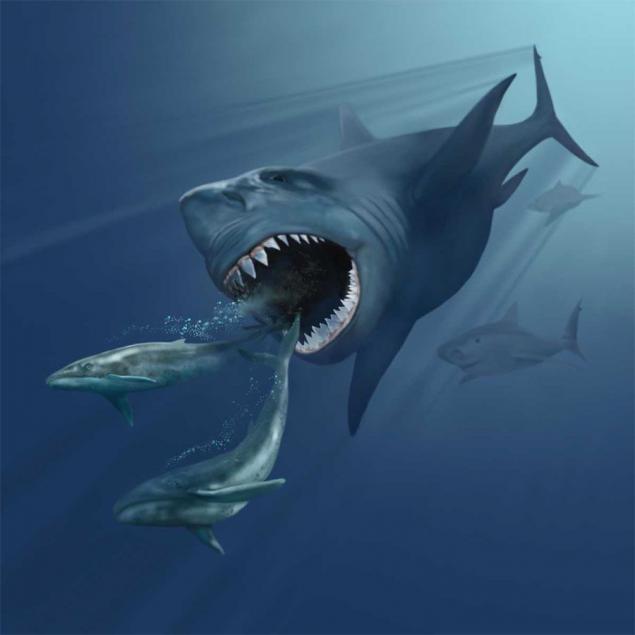
Megalodon teeth found throughout the world - in Europe, Africa, North and South America, India, Indonesia, Australia, New Caledonia and New Zealand. In other words, Megalodon was a cosmopolitan view. These kinds of broad, or as scientists say, universally spread is much less dependent on changes in the environment than the species with limited ranges. Under the influence of adverse changes may disappear a few local populations, but the rest of them, is likely to continue. Apparently, the mighty predator has been the victim of several unfavorable factors, some of which had far-reaching consequences.
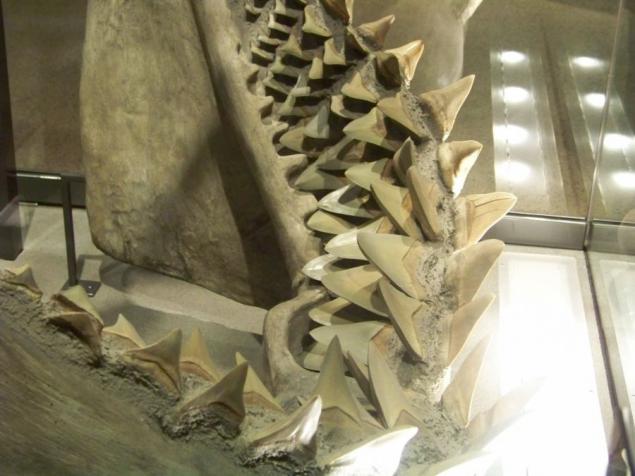
... Fffu-oo-oo-oo-oo-oo-oo !!! The plume of spray shot up the sky and steam. Fresh air filled with the powerful light and shiny spin whale briefly show on the surface, again disappeared in the waves. FFF-oo-oo-oo-oo! FFF-oo-oo-oo-xxxx !!! - Close relatives of exhaled loudly, and the waves were closing and parted over their glossy bodies. A small group of ancient whales slowly skirted the shallows.
Peace giants exchanged tinkling trills, habitually listening to the sea and drifting far away the voices of other whales. Close-old male brought up the rear, and it seemed no force on earth that could stop the movement of its enormous 10-meter body. Powerful tail - perpetual motion, tirelessly rose and fell, pushing the whale through the emerald water column, pectoral fins - depth rudders, leaning back regularly carried to the surface of the sea giant for a new breath.
And suddenly a mighty jerk shook the sea giant. The tail stung sharp pain. Keith cried! His tail began to move faster, but this speed is almost not increased. One-third of the left caudal blade was missing and a huge wound left a bloody trail. Whales, anxiously talking, turned into the open sea. Losing blood and weakening old male behind. The last thing he saw was a colossal shadow rapidly approaching it. The new breakthrough, and whale tail enveloped in a cloud of blood. A moment later a monstrous jaws closed on the pectoral fin whale. He was immobilized, he choked, he shouted! And someone even more huge, inexorably attacked again and again, pulling and swallowing chunks of meat still live ...

Megalodon - the most famous of all fossil sharks, familiar to most of us an enormous triangular teeth, sometimes reaching 18 (!) Cm in length and weighing up to 400 grams. Hard to believe that these massive stones were once teeth. Holding in hand a "tooth", it is impossible not to try to present, and what was the very "small fish". By the way, her name is Latin and translated - "a huge tooth". Dimensions are amazing and frightening. Megalodon - one of the greatest predators that ever existed on this planet. He is second only to the sperm whale, surpassing the size of many other whales and all known land predators, past and present. The Giants also, and especially, giant carnivores always aroused interest, and at the same time respectful awe. How many written about the lion, crocodile and tyrannosaur! And what do we know about Megalodon? It turns out - is extremely little. We have no idea what he looked like. Shark cartilage skeleton of a fossil almost preserved. All that is available to scientists, it is the teeth. Thousands of huge teeth ...
A world in which there was a Megalodon, very different from the one he left. The changes on our planet for 14 million years of its existence, were great. Continued continental drift changed the face of the seas and the continents themselves. During the Oligocene epoch Africa closer to Europe, and from the huge pool of sea between them were only Mediterranean, Black, Caspian and Aral seas. The Miocene crashed into the Indian subcontinent and Asia, while continuing to push him, helped form the Himalayas. Ascended to heaven the Rockies and the Andes. Geological processes of planetary scale influence on atmospheric circulation, change the direction of winds and rainfall patterns. Begun in the early Oligocene cooling reduced the average annual temperature of the air in the middle latitudes up to 15 ° C, and to kontsumiotsena (10 million years ago) started the largest glaciers on the poles of the Earth. This led to the fact that the sea level in a few million years, fell by primarily reducing the area of the shallow coastal seas. Thus, the movement of continents, lowering the temperature and reducing the area of the ocean can significantly reduce water area suitable for habitat Megalodon.
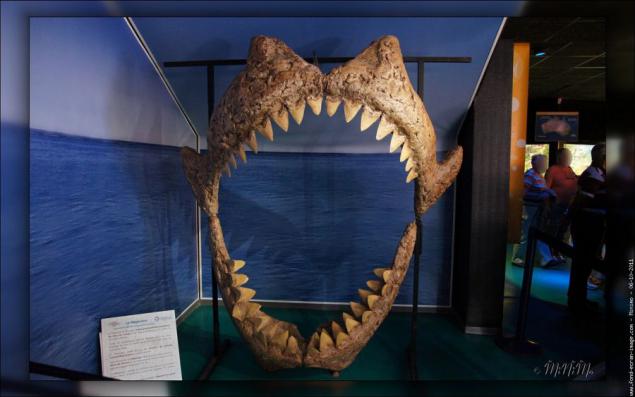
Atlantic continued to expand, and one of the consequences of displacement forming its bottom plate tectonics was the slowdown of the Gulf Stream. This, in turn, gradually reduce the amount of cold water rich in substances that rises to the surface from offshore south-eastern part of North America and therefore should be reflected in the diversity and number of organisms inhabiting these areas. It is the intensity of upwelling (upwelling in the seas and oceans, causing significant cooling of the sea surface) provides a wealth of life in many parts of the ocean. The disappearance tsetoteriid (earliest baleen whales), and the extinction of Megalodon is not just a coincidence. There is less plankton - fewer baleen whales. Whales disappeared - vanished food for Megalodon. By the way, talking about the disappearance of whales should be a caveat.
To be more precise to say that they have gone into more productive areas, that is, in cold water, where today lives most of their descendants. Excavations show that, for example, in the Antarctic whales have appeared in the late Pliocene, ie when the extinct Megalodon.

A week, a team of divers and archaeologists worked on the Cooper River just north of Charleston, in South Carolina. They were looking for anything that might be of scientific interest - from animal bones to the Civil War artifacts. Focuses on the whirlpool. Work them easily, but it is here that you can expect to find. For several boxes of samples were packed and were waiting for sending to the Institute of Archaeology. A couple more days, and I must go home. Summer 1974 came to an end.
When he returned to the Institute, an archaeologist finds spilled on the table. Giant fossil triangles matte poblёskivali on its white surface. As a child, laying out a pattern of black stones on the white sand, Patrick began to lay out the teeth size. Of course it turned out that it will soon have formed a sinister semicircle. Then the ring is closed. On the table lay a huge white black "jaws". Size shocked. What if…? Of course! Patrick knew about the famous reconstruction of the jaws of Megalodon, exhibited at the American Museum of Natural History in New York. Teeth that have been used to create it, were collected approximately at these locations. And if you like to create a layout?
Director of the Institute took one look to understand the idea of McCarthy. The following year, already the whole group of underwater archaeologists collected the teeth of ancient monsters. Those that had the best safety, transferred to museums or sold to collectors to recoup the cost of underwater operations. Together with one of his friends, Patrick collected all available at the time the data of the teeth and jaws of the ancient and modern sharks, and made the first model of the jaws of Megalodon, which consisted of fiberglass jaws 1.5 m high and 1.8 m wide, and contained 175 of these teeth . Nowadays it is exhibited at the State Museum of South Carolina.
In the 20 years that have passed since that time, Patrick has created several dozens of models jaw Megalodon, constantly improving their production techniques, and, most importantly, their compliance with the latest scientific data. To date, the most accurate is the model height of 2.1 m and a width of 2.7 m and 5 rows of teeth comprising a total of 230. Impressive?
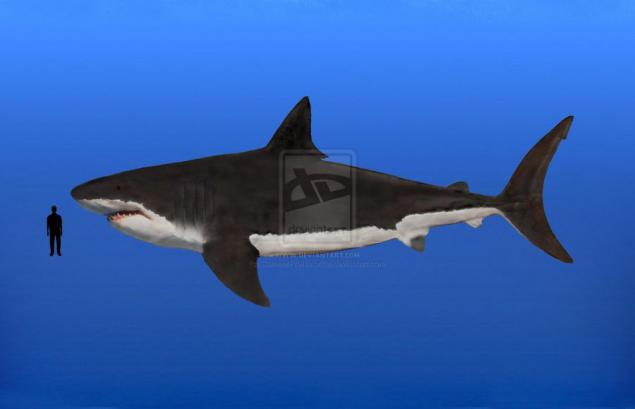
Carcharodon or Carcharocles?
Fossilized Megalodon teeth in shape very similar to teeth great white shark (Carcharodon carcharias), which, in turn, is the largest predatory fish of today. Differences, however, also plenty (Megalodon teeth, for example, much thicker, and the barbs on their edges and less correct than the teeth big white). But some paleontologists believe that the age difference is gradually smoothed out, and the teeth of the largest specimens of white sharks are very similar to the teeth of a giant fossil counterpart. This similarity has led to the existence of two points of view on the degree of kinship of the two monsters. Some scientists suggest that Megalodon and White Death - close relatives, and therefore must be included together in the genus Carcharodon. Their opponents also find that the similarity in the structure of the teeth only superficial, acquired due to similar lifestyles and "terrible pair" consists of two separate lines in the pedigree pilozubyh sharks. For this reason, they include Megalodon in the genus Carcharocles. This dispute long time, and no end in sight - too many gaps in our knowledge of ancient sharks. Nevertheless, supporters of different points of view agree in the following paragraphs:
(1) Megalodon existed relatively "recently" appeared in the seas and disappeared 16 million years ago, 1.6;
(2) he was not a direct ancestor of the great white shark.

Reconstructing Megalodon
So stone teeth - it is almost all that remains of an enormous predator. Incidentally, the teeth of fossil sharks can be almost any color - there are black, gray, purple, blue, green, brown, red, pink, orange, yellow, beige, off-white - depending on the chemical composition of the sediment in which they are found. People have been familiar with them for a long time, and Pliny wrote that they fall to the ground during lunar eclipses.
Did you know that the teeth Megalodon became the first paleontological objects described and showed in the scientific literature? In 1667, the court doctor of Duke of Tuscany, Niels Stencil (Steno), has published a booklet entitled "Description be cut off shark's head," which, in addition to accurate descriptions and images of the head Great White, he described and drew the so-called "stone languages» (glossopetrae ). For centuries, the triangular smooth stones found in the scree on the island of Malta. Many, including their fossilized tongues of snakes, of which St. Paul turned to stone during his visit to the island, Megalodon teeth are used as talismans against the bites of poisonous reptiles. So the walls, which for this reason should be regarded as the first paleontologist, noted the similarities between the teeth white shark and glossopetrami, and suggested that the past is nothing but the teeth of ancient sharks.

The obvious way to begin reconstruction Megalodon - put them on the frame that simulates cartilage skeleton of the jaws of a shark. Immediately raises two questions - how big was the jaw and teeth as they contain? Based on the similarity to the white shark, teeth, which is 3 times less, it seems quite natural to extrapolate the basic proportions of contemporary predator on the Megalodon. Curator of the Museum of Natural History at first did so. The first model of his jaws at the beginning of the twentieth century did Beshford Professor Ding said the American Museum of Natural History, in New York. Standing next to such a layout, it is impossible not to shudder: jaw height of 3.4 m and a width of 2.75 m! Rhino slip - do not be late! A famous photograph taken at the New York museum, in the opening plaster Megalodon jaws fit 6 people! Given the size of the monstrous jaws, the length of its proprietress was estimated at 25-30 meters !!! Is it any wonder that the museum layouts Megalodon jaws are still among the most popular exhibits.
But how great was this unique establishment really? The height of the largest teeth in the jaws of a great white shark is the height of its upper jaw. Early models Megalodon jaws were made without taking into account the proportion of the height of the upper jaw in them is three times greater than the height of the teeth. There is another relationship: the length of the part of the white shark tooth that is covered by enamel, proportional to the length of her body. Assuming that the Megalodon is to increase the "big white", its size should not exceed 13 m.
Whence came the myth of the 25-meter monster? Why is the creation of the first reconstruction was made such a mistake? But the fact that these models were built using approximately the same size teeth belonging to different instances of the Megalodon. At the same time, the teeth of shark pilozubyh advanced to the corners of the mouth is significantly reduced in size. If you do not take into account this feature, the jaws of sharks get much more.
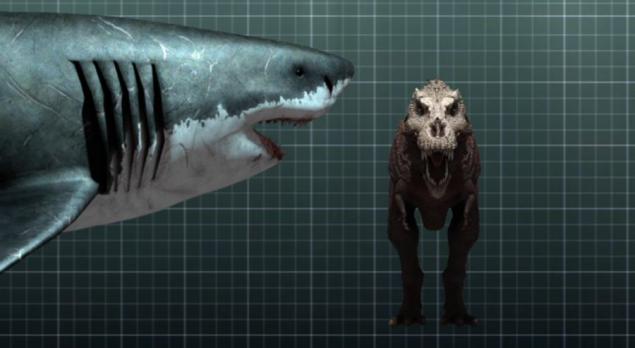
In 1992, the American paleontologist John Macy had the opportunity to study a relatively complete set of teeth Megalodon found in one of the quarries of North Carolina. Using the above-mentioned proportions, as well as the results of their own studies of the teeth and jaws of sharks, Macy has created a new model of the jaws of fossil monster, which had a 1.8 m in diameter, and thus corresponds to the shark a length of 12 m. Megalodon "cringed" even stronger, although not this became less scary.
However, a few years later, there is evidence, according to which the great white shark teeth cease to increase after reaching its length of 5 meters. In other words, and 5-and 6-and 7-meter white shark teeth have the same size. It is likely that the Megalodon was characterized by the same features. A new approach to the calculation of the fossil shark gave a new approach. Today, the maximum length of this monster is estimated at 15-20 m and weighs 48 tons. For comparison, the largest measured white shark reaches 7.1 meters and weighs 2.3 tons. Dorsal fin Megalodon reached 1.7 m breast - 3.1 meters and the height of the tail - 3.8 m. It is not easy to imagine a shark 3 m long. But what about the shark, which has 3 m - Diameter of the body, and from the tip of the pectoral fin to the tip of the other - 9 m ?! It's a small plane! Incidentally, we note that the majority of the female sharks are much larger than males. So, speaking of the 15-meter Megalodon, we mean "Megalodonihu».
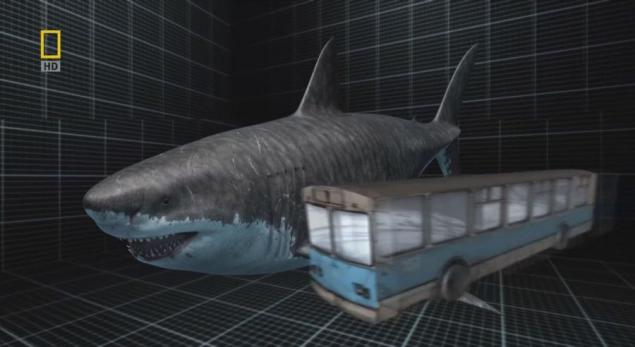
All of the above methods of reconstruction of fossil monster based on his remains. However, there is another way to measure the "neizmeryamoe." Sharks breathe using gills. The rate of gas exchange through its surface depending on the water temperature and the concentration gradient, dissolved in water and shark blood gases. Since the increase in the surface area of the body, its volume increases in the cube, you can roughly calculate the size of the body Megalodon that his gills were able to provide oxygen. These calculations gave approximately the same figures - 15.1 m.
In the flesh Megalodon, presumably, had a relatively higher and broader skull than the white shark, a short, blunt snout and a massive jaw. As they say jokers, Megalodon 'face was a pig. " He also had more vertebrae and pectoral fins were proportional to the length. In other words, Megalodon was the more powerful, and if I may say so with respect to the cartilaginous fish, "big-boned". A kind of big white option "on steroids».
There is, however, another view (considered almost heretical), also based on a comparison of the reconstruction of shark teeth and pedigree. According to him, more like Megalodon not White's death, and one type of nurse sharks (Odontaspis taurus), also called "sand tiger." Do not be surprised in science paradoxical point of view, it is extremely useful. They allow you to look at things from an unexpected direction and overestimate stereotypes.
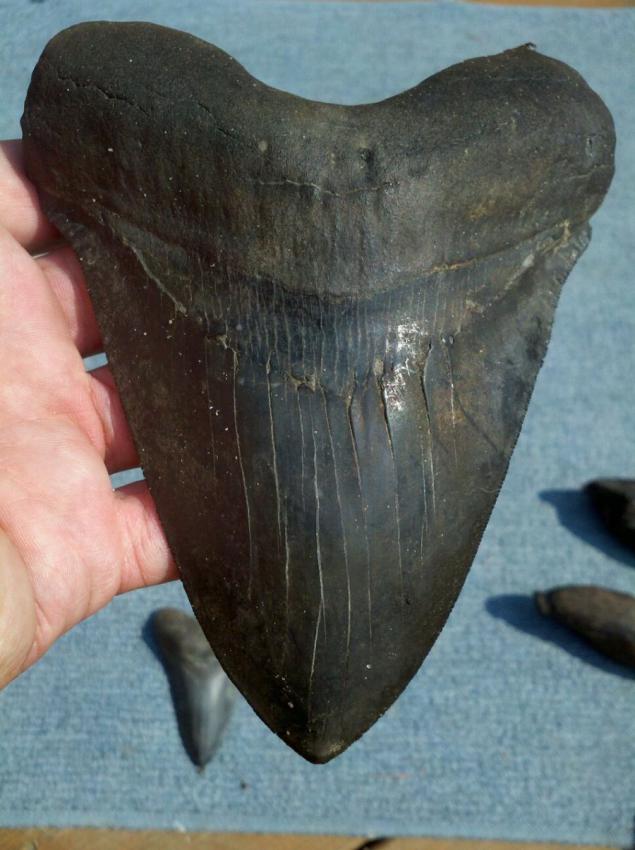
The emergence and flourishing of Megalodon
White Shark near Megalodon was that beside the crocodile Godzilla - tiny and much less sinister variation on the same theme. Interestingly, for almost 10 million years, these two types were contemporaries. How "small" and worse armed white shark has managed to survive in the shadow of his monstrous relative happily existed until today, while the extinct Megalodon?
The history of life on our planet - is the story of ecosystems and paleoecology - the science of restoring what they were and how to function.

Megalodon teeth found throughout the world - in Europe, Africa, North and South America, India, Indonesia, Australia, New Caledonia and New Zealand. In other words, Megalodon was a cosmopolitan view. These kinds of broad, or as scientists say, universally spread is much less dependent on changes in the environment than the species with limited ranges. Under the influence of adverse changes may disappear a few local populations, but the rest of them, is likely to continue. Apparently, the mighty predator has been the victim of several unfavorable factors, some of which had far-reaching consequences.

... Fffu-oo-oo-oo-oo-oo-oo !!! The plume of spray shot up the sky and steam. Fresh air filled with the powerful light and shiny spin whale briefly show on the surface, again disappeared in the waves. FFF-oo-oo-oo-oo! FFF-oo-oo-oo-xxxx !!! - Close relatives of exhaled loudly, and the waves were closing and parted over their glossy bodies. A small group of ancient whales slowly skirted the shallows.
Peace giants exchanged tinkling trills, habitually listening to the sea and drifting far away the voices of other whales. Close-old male brought up the rear, and it seemed no force on earth that could stop the movement of its enormous 10-meter body. Powerful tail - perpetual motion, tirelessly rose and fell, pushing the whale through the emerald water column, pectoral fins - depth rudders, leaning back regularly carried to the surface of the sea giant for a new breath.
And suddenly a mighty jerk shook the sea giant. The tail stung sharp pain. Keith cried! His tail began to move faster, but this speed is almost not increased. One-third of the left caudal blade was missing and a huge wound left a bloody trail. Whales, anxiously talking, turned into the open sea. Losing blood and weakening old male behind. The last thing he saw was a colossal shadow rapidly approaching it. The new breakthrough, and whale tail enveloped in a cloud of blood. A moment later a monstrous jaws closed on the pectoral fin whale. He was immobilized, he choked, he shouted! And someone even more huge, inexorably attacked again and again, pulling and swallowing chunks of meat still live ...

Megalodon - the most famous of all fossil sharks, familiar to most of us an enormous triangular teeth, sometimes reaching 18 (!) Cm in length and weighing up to 400 grams. Hard to believe that these massive stones were once teeth. Holding in hand a "tooth", it is impossible not to try to present, and what was the very "small fish". By the way, her name is Latin and translated - "a huge tooth". Dimensions are amazing and frightening. Megalodon - one of the greatest predators that ever existed on this planet. He is second only to the sperm whale, surpassing the size of many other whales and all known land predators, past and present. The Giants also, and especially, giant carnivores always aroused interest, and at the same time respectful awe. How many written about the lion, crocodile and tyrannosaur! And what do we know about Megalodon? It turns out - is extremely little. We have no idea what he looked like. Shark cartilage skeleton of a fossil almost preserved. All that is available to scientists, it is the teeth. Thousands of huge teeth ...
A world in which there was a Megalodon, very different from the one he left. The changes on our planet for 14 million years of its existence, were great. Continued continental drift changed the face of the seas and the continents themselves. During the Oligocene epoch Africa closer to Europe, and from the huge pool of sea between them were only Mediterranean, Black, Caspian and Aral seas. The Miocene crashed into the Indian subcontinent and Asia, while continuing to push him, helped form the Himalayas. Ascended to heaven the Rockies and the Andes. Geological processes of planetary scale influence on atmospheric circulation, change the direction of winds and rainfall patterns. Begun in the early Oligocene cooling reduced the average annual temperature of the air in the middle latitudes up to 15 ° C, and to kontsumiotsena (10 million years ago) started the largest glaciers on the poles of the Earth. This led to the fact that the sea level in a few million years, fell by primarily reducing the area of the shallow coastal seas. Thus, the movement of continents, lowering the temperature and reducing the area of the ocean can significantly reduce water area suitable for habitat Megalodon.

Atlantic continued to expand, and one of the consequences of displacement forming its bottom plate tectonics was the slowdown of the Gulf Stream. This, in turn, gradually reduce the amount of cold water rich in substances that rises to the surface from offshore south-eastern part of North America and therefore should be reflected in the diversity and number of organisms inhabiting these areas. It is the intensity of upwelling (upwelling in the seas and oceans, causing significant cooling of the sea surface) provides a wealth of life in many parts of the ocean. The disappearance tsetoteriid (earliest baleen whales), and the extinction of Megalodon is not just a coincidence. There is less plankton - fewer baleen whales. Whales disappeared - vanished food for Megalodon. By the way, talking about the disappearance of whales should be a caveat.
To be more precise to say that they have gone into more productive areas, that is, in cold water, where today lives most of their descendants. Excavations show that, for example, in the Antarctic whales have appeared in the late Pliocene, ie when the extinct Megalodon.

A week, a team of divers and archaeologists worked on the Cooper River just north of Charleston, in South Carolina. They were looking for anything that might be of scientific interest - from animal bones to the Civil War artifacts. Focuses on the whirlpool. Work them easily, but it is here that you can expect to find. For several boxes of samples were packed and were waiting for sending to the Institute of Archaeology. A couple more days, and I must go home. Summer 1974 came to an end.
When he returned to the Institute, an archaeologist finds spilled on the table. Giant fossil triangles matte poblёskivali on its white surface. As a child, laying out a pattern of black stones on the white sand, Patrick began to lay out the teeth size. Of course it turned out that it will soon have formed a sinister semicircle. Then the ring is closed. On the table lay a huge white black "jaws". Size shocked. What if…? Of course! Patrick knew about the famous reconstruction of the jaws of Megalodon, exhibited at the American Museum of Natural History in New York. Teeth that have been used to create it, were collected approximately at these locations. And if you like to create a layout?
Director of the Institute took one look to understand the idea of McCarthy. The following year, already the whole group of underwater archaeologists collected the teeth of ancient monsters. Those that had the best safety, transferred to museums or sold to collectors to recoup the cost of underwater operations. Together with one of his friends, Patrick collected all available at the time the data of the teeth and jaws of the ancient and modern sharks, and made the first model of the jaws of Megalodon, which consisted of fiberglass jaws 1.5 m high and 1.8 m wide, and contained 175 of these teeth . Nowadays it is exhibited at the State Museum of South Carolina.
In the 20 years that have passed since that time, Patrick has created several dozens of models jaw Megalodon, constantly improving their production techniques, and, most importantly, their compliance with the latest scientific data. To date, the most accurate is the model height of 2.1 m and a width of 2.7 m and 5 rows of teeth comprising a total of 230. Impressive?

Carcharodon or Carcharocles?
Fossilized Megalodon teeth in shape very similar to teeth great white shark (Carcharodon carcharias), which, in turn, is the largest predatory fish of today. Differences, however, also plenty (Megalodon teeth, for example, much thicker, and the barbs on their edges and less correct than the teeth big white). But some paleontologists believe that the age difference is gradually smoothed out, and the teeth of the largest specimens of white sharks are very similar to the teeth of a giant fossil counterpart. This similarity has led to the existence of two points of view on the degree of kinship of the two monsters. Some scientists suggest that Megalodon and White Death - close relatives, and therefore must be included together in the genus Carcharodon. Their opponents also find that the similarity in the structure of the teeth only superficial, acquired due to similar lifestyles and "terrible pair" consists of two separate lines in the pedigree pilozubyh sharks. For this reason, they include Megalodon in the genus Carcharocles. This dispute long time, and no end in sight - too many gaps in our knowledge of ancient sharks. Nevertheless, supporters of different points of view agree in the following paragraphs:
(1) Megalodon existed relatively "recently" appeared in the seas and disappeared 16 million years ago, 1.6;
(2) he was not a direct ancestor of the great white shark.

Reconstructing Megalodon
So stone teeth - it is almost all that remains of an enormous predator. Incidentally, the teeth of fossil sharks can be almost any color - there are black, gray, purple, blue, green, brown, red, pink, orange, yellow, beige, off-white - depending on the chemical composition of the sediment in which they are found. People have been familiar with them for a long time, and Pliny wrote that they fall to the ground during lunar eclipses.
Did you know that the teeth Megalodon became the first paleontological objects described and showed in the scientific literature? In 1667, the court doctor of Duke of Tuscany, Niels Stencil (Steno), has published a booklet entitled "Description be cut off shark's head," which, in addition to accurate descriptions and images of the head Great White, he described and drew the so-called "stone languages» (glossopetrae ). For centuries, the triangular smooth stones found in the scree on the island of Malta. Many, including their fossilized tongues of snakes, of which St. Paul turned to stone during his visit to the island, Megalodon teeth are used as talismans against the bites of poisonous reptiles. So the walls, which for this reason should be regarded as the first paleontologist, noted the similarities between the teeth white shark and glossopetrami, and suggested that the past is nothing but the teeth of ancient sharks.

The obvious way to begin reconstruction Megalodon - put them on the frame that simulates cartilage skeleton of the jaws of a shark. Immediately raises two questions - how big was the jaw and teeth as they contain? Based on the similarity to the white shark, teeth, which is 3 times less, it seems quite natural to extrapolate the basic proportions of contemporary predator on the Megalodon. Curator of the Museum of Natural History at first did so. The first model of his jaws at the beginning of the twentieth century did Beshford Professor Ding said the American Museum of Natural History, in New York. Standing next to such a layout, it is impossible not to shudder: jaw height of 3.4 m and a width of 2.75 m! Rhino slip - do not be late! A famous photograph taken at the New York museum, in the opening plaster Megalodon jaws fit 6 people! Given the size of the monstrous jaws, the length of its proprietress was estimated at 25-30 meters !!! Is it any wonder that the museum layouts Megalodon jaws are still among the most popular exhibits.
But how great was this unique establishment really? The height of the largest teeth in the jaws of a great white shark is the height of its upper jaw. Early models Megalodon jaws were made without taking into account the proportion of the height of the upper jaw in them is three times greater than the height of the teeth. There is another relationship: the length of the part of the white shark tooth that is covered by enamel, proportional to the length of her body. Assuming that the Megalodon is to increase the "big white", its size should not exceed 13 m.
Whence came the myth of the 25-meter monster? Why is the creation of the first reconstruction was made such a mistake? But the fact that these models were built using approximately the same size teeth belonging to different instances of the Megalodon. At the same time, the teeth of shark pilozubyh advanced to the corners of the mouth is significantly reduced in size. If you do not take into account this feature, the jaws of sharks get much more.

In 1992, the American paleontologist John Macy had the opportunity to study a relatively complete set of teeth Megalodon found in one of the quarries of North Carolina. Using the above-mentioned proportions, as well as the results of their own studies of the teeth and jaws of sharks, Macy has created a new model of the jaws of fossil monster, which had a 1.8 m in diameter, and thus corresponds to the shark a length of 12 m. Megalodon "cringed" even stronger, although not this became less scary.
However, a few years later, there is evidence, according to which the great white shark teeth cease to increase after reaching its length of 5 meters. In other words, and 5-and 6-and 7-meter white shark teeth have the same size. It is likely that the Megalodon was characterized by the same features. A new approach to the calculation of the fossil shark gave a new approach. Today, the maximum length of this monster is estimated at 15-20 m and weighs 48 tons. For comparison, the largest measured white shark reaches 7.1 meters and weighs 2.3 tons. Dorsal fin Megalodon reached 1.7 m breast - 3.1 meters and the height of the tail - 3.8 m. It is not easy to imagine a shark 3 m long. But what about the shark, which has 3 m - Diameter of the body, and from the tip of the pectoral fin to the tip of the other - 9 m ?! It's a small plane! Incidentally, we note that the majority of the female sharks are much larger than males. So, speaking of the 15-meter Megalodon, we mean "Megalodonihu».

All of the above methods of reconstruction of fossil monster based on his remains. However, there is another way to measure the "neizmeryamoe." Sharks breathe using gills. The rate of gas exchange through its surface depending on the water temperature and the concentration gradient, dissolved in water and shark blood gases. Since the increase in the surface area of the body, its volume increases in the cube, you can roughly calculate the size of the body Megalodon that his gills were able to provide oxygen. These calculations gave approximately the same figures - 15.1 m.
In the flesh Megalodon, presumably, had a relatively higher and broader skull than the white shark, a short, blunt snout and a massive jaw. As they say jokers, Megalodon 'face was a pig. " He also had more vertebrae and pectoral fins were proportional to the length. In other words, Megalodon was the more powerful, and if I may say so with respect to the cartilaginous fish, "big-boned". A kind of big white option "on steroids».
There is, however, another view (considered almost heretical), also based on a comparison of the reconstruction of shark teeth and pedigree. According to him, more like Megalodon not White's death, and one type of nurse sharks (Odontaspis taurus), also called "sand tiger." Do not be surprised in science paradoxical point of view, it is extremely useful. They allow you to look at things from an unexpected direction and overestimate stereotypes.

The emergence and flourishing of Megalodon
White Shark near Megalodon was that beside the crocodile Godzilla - tiny and much less sinister variation on the same theme. Interestingly, for almost 10 million years, these two types were contemporaries. How "small" and worse armed white shark has managed to survive in the shadow of his monstrous relative happily existed until today, while the extinct Megalodon?
The history of life on our planet - is the story of ecosystems and paleoecology - the science of restoring what they were and how to function.



